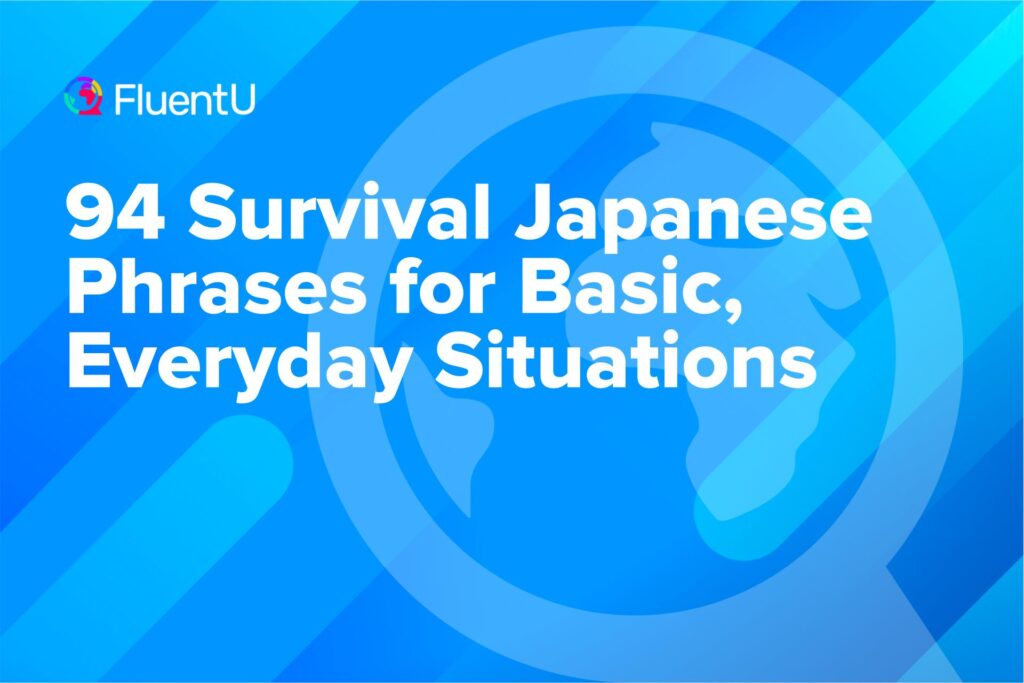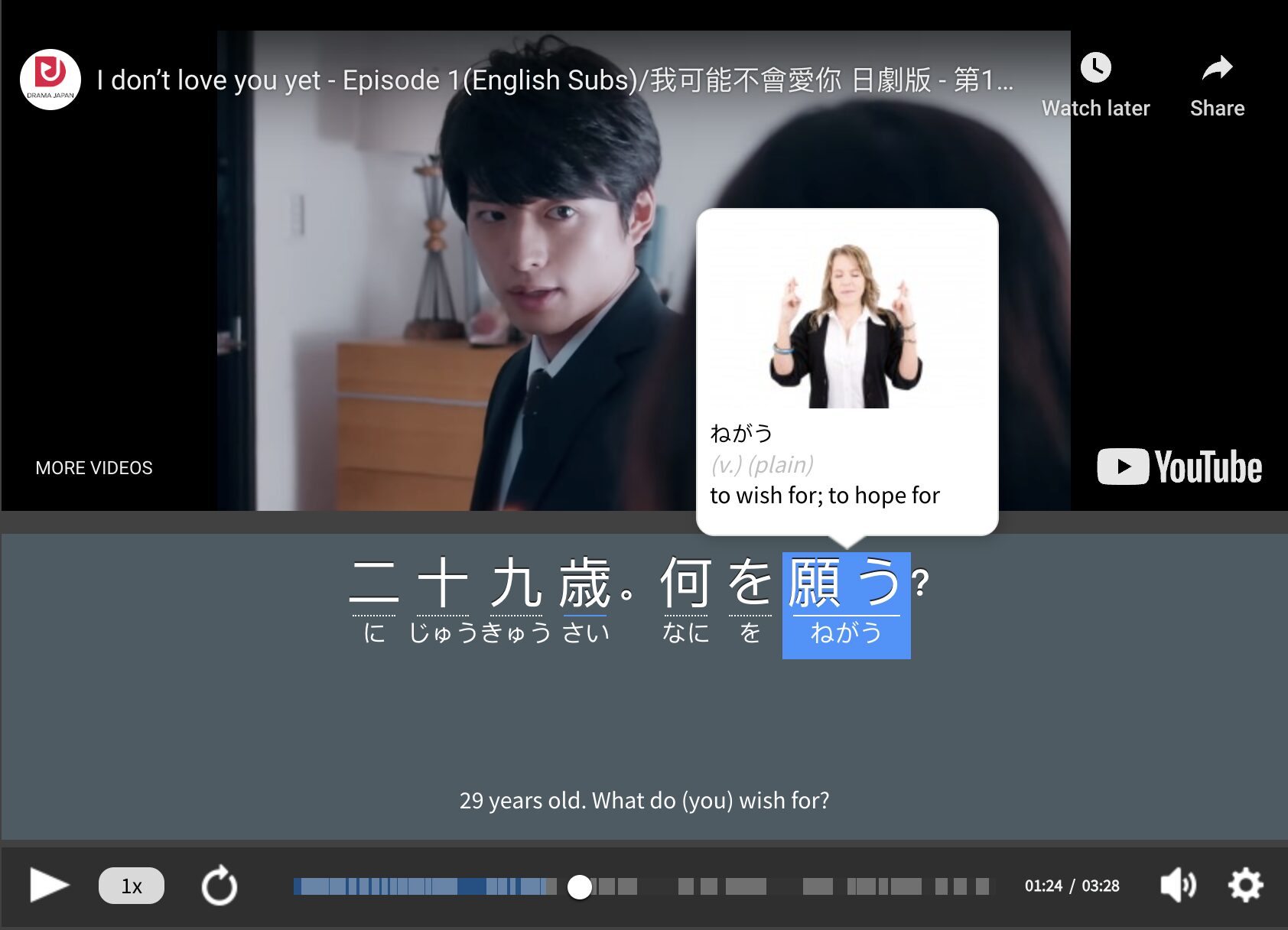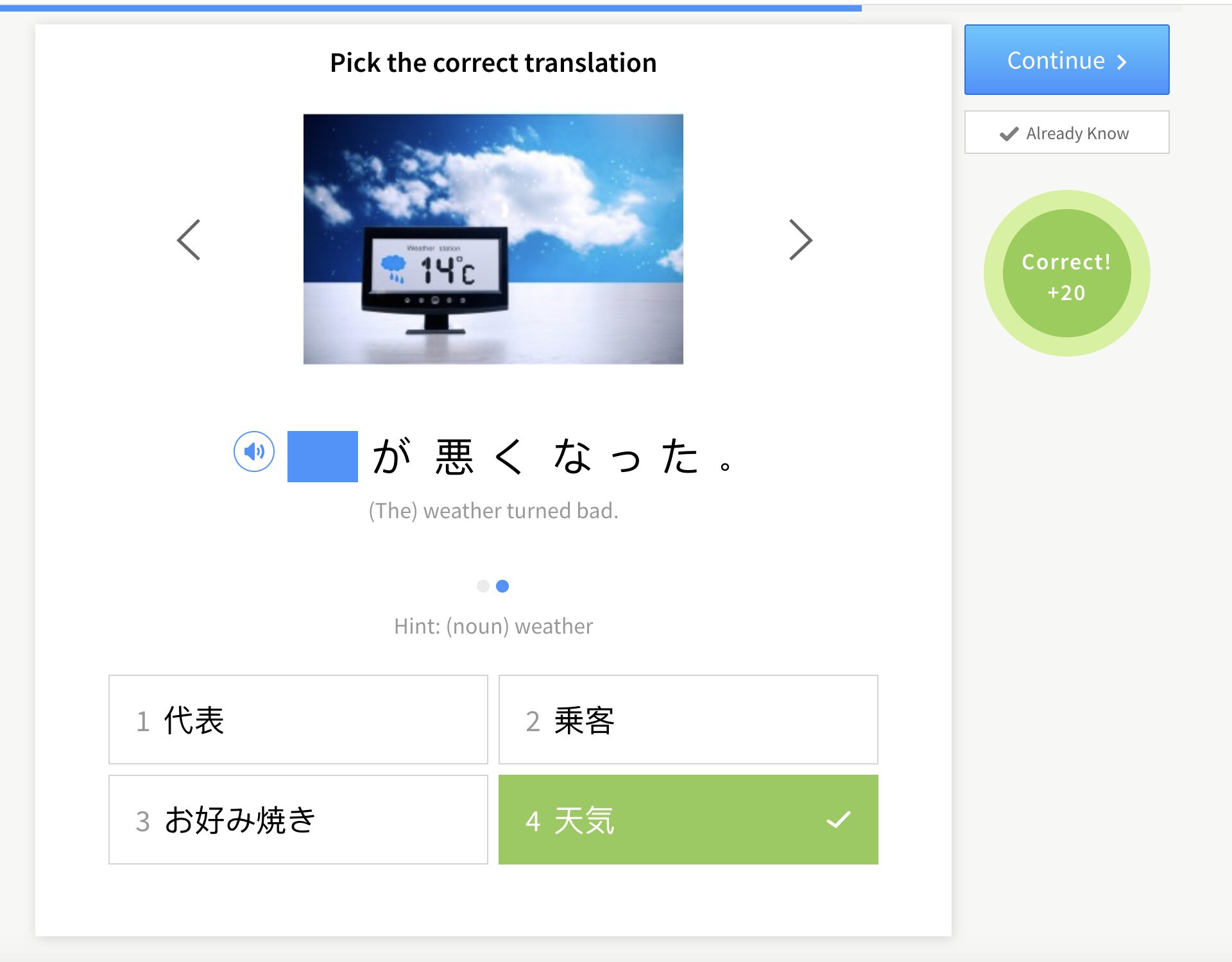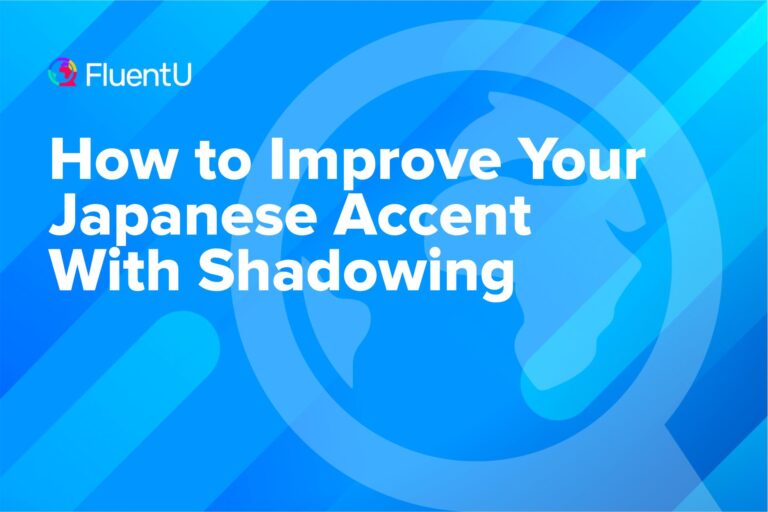94 Survival Japanese Phrases for Basic, Everyday Situations

I’ve been learning Japanese for a few years, including a year of formal university studies. So when I visited Japan this year, I felt ready to use all my learned Japanese skills. In reality, though, over the course of our 14-day stay in Tokyo and Izu, I found myself using the same handful of phrases over and over.
Regardless of your reasons for visiting or your language level, these survival Japanese phrases are the ones I found most useful when traveling around Japan.
Download: This blog post is available as a convenient and portable PDF that you can take anywhere. Click here to get a copy. (Download)
Greetings and Introductions
Note that there isn’t a general term for “hello” in Japanese. Instead, you need to use the correct phrase for the time of day. Alternatively, just bow lightly to say hello. Bowing is extremely common in Japan, and I found myself bobbing my head at everyone from hotel staff to passersby on the street.
- Good morning — ohayou gozaimasu ( おはようございます
)
You can also say ohayou ( おはよう ) in more casual environments. - Good afternoon — konnichiwa ( こんにちは )
- Good evening — konbanwa ( こんばんは )
- Hello — moshi moshi ( もしもし
)
Only use this phrase when answering a phone. - Nice to meet you — hajimemashite ( はじめまして )
- My name is XX — watashi no namae wa XX desu ( 私の名前はXXです
)
You can drop the “my” in this sentence and simply say namae wa XX desu ( 名前はXXです ), or namae wa XX ( 名前はXX ). - How are you? — ogenkidesuka ( お元気ですか? )
- I’m home — tadaima ( ただいま
)
Say this when you return to your home, hotel or wherever you happen to be staying. Many Japanese people say this when they return home regardless of whether there’s someone there to greet them. - Welcome home — okaerinasai ( おかえりなさい
)
This is the response to tadaima, said by whoever is home when you return.
Goodbyes
- Good night — oyasuminasai ( おやすみなさい )
- Goodbye — jaa mata ( じゃあまた
)
An alternative to this Japanese goodbye is Jaa ne ( じゃあね ). - Bye-bye — bai bai ( バイバイ
)
This one’s super informal and mostly used by women. - Farewell — sayounara ( さようなら
)
Only use this expression with someone who you won’t see for a long time. Though many non-Japanese speakers are familiar with the word, it’s rare to hear it outside of long goodbyes. - Thank you for a hard day’s work (formal) — otsukaresama deshita ( お疲れ様でした
)
Although it’s not technically a goodbye, this phrase is often used when leaving someplace formal, like a workplace. - Excuse me for leaving before you (formal) — osaki ni shitsurei shimasu ( お先に失礼します )
- I’m off now — ittekimasu ( 行ってきます
)
Japanese people say this when they leave home. Like with tadaima, this is often said even if there’s no one to say goodbye to. - Have a nice trip — itterasshai ( 行ってらっしゃい
)
This is the response to ittekimasu, said by whoever is staying behind at home. My host at the Izu resort always said this to my family when we left for our day’s adventure.
Being Polite
- Please — onegai shimasu ( お願いします )
- Thank you — arigatou ( ありがとう )
- Thanks — doumo ( どうも
)
This is a more informal way to say thank you. - Thank you (formal) — arigatou gozaimasu ( ありがとうございます
)
If you’re thanking someone for something they did for you in the past, you can use the past tense of this, arigatou gozaimashita ( ありがとうございました ). - Thank you very much (formal) — doumo arigatou gozaimasu ( どうもありがとうございます
)
As with the previous phrase, you can use the past tense for something done for you in the past doumo arigatou gozaimashita ( どうもありがとうございました ). - You’re welcome — dou itashimashite ( どういたしまして
)
Although this is the “proper” way to respond to someone thanking you, it’s not actually used that often. It sounds more natural to simply respond with iie, iie, which literally means “no, no” but is a way to say “There’s nothing to thank me for.”
You’ll discover that a number of the things you were taught in your textbook aren’t necessarily the way Japanese people actually speak. You can get a better sense of natural Japanese speech by watching authentic videos with embedded learning tools on the FluentU program.
FluentU takes authentic videos—like music videos, movie trailers, news and inspiring talks—and turns them into personalized language learning lessons.
You can try FluentU for free for 2 weeks. Check out the website or download the iOS app or Android app.
P.S. Click here to take advantage of our current sale! (Expires at the end of this month.)

- Same to you — kochira koso ( こちら こそ
)
This is another way to respond when receiving thanks. It’s a casual way to say “no, thank you.” You can also use this phrase when someone tells you to have a nice day or anything else that you’d like to wish back to the speaker. - Excuse me — sumimasen ( すみません
)
This was my most frequently used word in Japan, hands down. You use it to get someone’s attention, to excuse yourself from a room, when passing someone, to thank someone for their help and more. Our Airbnb host even used it when I dropped something! - Go ahead — douzo ( どうぞ
)
This is a polite way to let someone know they can go ahead of you. I used it when letting someone order at a café before me, and when I accidentally got in front of someone trying to use the stairs. - Yes — hai ( はい
)
You can also use this word to show that you’re listening as someone talks. - No — iie ( いいえ )
Asking for Help
- Please XX — XX kudasai ( XXください
)
You can’t use kudasai on its own. It requires more than one word to ask for something specific, as in “Please perform this action.” Although the FamilyMart convenience store worker might take it in stride if you were to ask for a pastry by pointing and saying kudasai, this isn’t grammatically correct. - Please repeat that — mou ichido itte kudasai ( もう一度言ってください )
- Please speak slowly — yukkuri hanashite kudasai ( ゆっくり話してください )
- Please — onegaishimasu ( お願いします
)
Unlike kudasai, you can use onegaishimasu to say “please” on its own. This is, in fact, the word you’d use when pointing to that pastry that you want. - Say that again, please — mou ichido, onegaishimasu ( もう 一度、 お願いします
)
This is an alternative to using kudasai. It’s easier to remember since you don’t even need to use a verb to be understood. - Can you help me, please? — tasukete moraemasu ka? ( 助けてもらえますか? )
- Do you speak English? — eigo o hanashimasu ka? ( 英語を話しますか? )
- I don’t understand — wakarimasen ( 分かりません )
- I understand — wakarimasu ( 分かります )
- Can you stamp this, please? — kore ni hanko o onegaishimasu ( これに判子をお願いします
)
There are rubber ink stamp stations located all around Japan, including in most train stations. Use this phrase when visiting museums and historical locations, and you might get an extra special stamp. There’s even a stamp rally that challenges you to get 24 stamps at Japanese castles. Can you collect them all? - I’d like to buy a SIM card — SIM kādo o kaitai desu ( SIMカードを買いたいです
)
Buying a SIM card is a must when visiting Japan so you can use your phone anywhere. They’re simple to use and not too expensive. While you can buy these in many places around Japan, I recommend purchasing them ahead of time for a better price and convenience. I did this when I visited, and my SIM card was waiting for me when I arrived at the airport. Easy! - Is this okay? — kore wa ii desu ka? ( これでいいですか?
)
You can use this as a catch-all when asking for permission or making sure it’s okay to do something.
Shopping
- This, please — kore o onegaishimasu ( これをお願いします
)
Use this phrase to point out something that you want to buy. It’s especially useful if you don’t know the word for the object you want to buy. - Do you take credit card? — kurejitto kaado wa tsukaemasu ka? ( クレジットカードは使えますか?
)
Many places in Japan only take cash, so it’s important to ask before you head in to buy anything with a card. You can also simplify this—one of my most commonly used phrases during my trip to Japan was Caado wa ii desu ka? ( カードは いい です か? ), basically asking “Is card okay?” - Where is XX? — XX wa doko desu ka? ( XXはどこですか? )
- What is this? — kore wa nan desu ka? ( これは何ですか?
)
Use kore (これ) when referring to something close to you. For something close to the listener but far from you, use sore ( それ ) and for something far away from both you and the listener, use are ( あれ ). - How much is this? — kore wa ikura desu ka? ( これはいくらですか? )
- You can also simply ask ikura desu ka? ( いくらですか? ), which means the same.
- Is this tax-free? — kore wa menzei desu ka? ( これは免税ですか?
)
Tourists visiting Japan don’t have to pay taxes when shopping there. In many places, you can simply show your passport when paying, but some locations have special places where you can get back any tax money you’ve spent. So hang on to your receipts and always have your passport on hand! - Welcome — irasshaimase ( いらっしゃいませ
)
Store clerks sometimes use this phrase to welcome you to their store. Although I heard it a couple of times in Izu, no one in Tokyo seemed to use it at all. I was much more likely to be greeted with one of the phrases below. - Thanks for visiting XX — XX e no go-raiseki arigatou gozaimasu ( XXへのご来席ありがとうございます )
- Welcome to XX — XX e yōkoso ( XXへようこそ )
- Next customer — tsugi no okyaku-sama desu ( 次のお客様です )
- Thank you for waiting — omatase shimashita ( お待たせしました )
- Do you have a membership card? — kaiin kādo o o mochidesu ka? ( 会員カードをお持ちですか?
)
This one always threw me off because I wasn’t expecting it. It’s said often and very quickly, in the same way that you might hear “Welcome to McDonald’s, can I take your order?” - How will you be paying? — dono yōni o shiharai shimasu ka? ( どのようにお支払いしますか? )
- Do you need a bag? — fukuro wa irimasu ka? ( 袋はいりますか?
)
I was asked this at least five different ways across different stores. To spot the question, keep an ear out for the words fukuro ( 袋 ) or reji bukuro ( レジ袋 ). - Please use the screen / computer — sukuin / konpyūta o tsukatte kudasai ( スクリーン/コンピュータを使ってください
)
If you’re paying by credit card, you’ll be directed to a computer screen to make your payment. These usually allow you to choose English as your language, and then simply follow the prompts that follow. - Your change is XX — otsuri wa XX desu ( お釣りはXXです )
Eating at a Restaurant
- How many people? — nan-mei sama desu ka? ( 何名様ですか?
)
This is what you’ll be asked when entering a restaurant. The correct way to respond is below, but you can also say ichi ( 一 ), ni ( 二 ), san ( 三 ) or yon ( 四 ) and be understood. - One person — hitori desu ( 一人です )
- Two people — futari desu ( 二人です )
- Three people — sannin desu ( 三人です )
- Four people — yonin desu ( 四人です )
- Can I have the Japanese menu, please? — nihongo no menyū o onegaishimasu ( 日本語のメニューをお願いします
)
Some places in Japan that are popular with tourists have English menus. However, the prices on these menus can be inflated. If a waiter offers you an English-language menu, you can ask for a Japanese one instead, and simply use Google Lens or a similar app to translate the menu text. - I’d like this, please — kore o onegaishimasu ( これをお願いします
)
When you use this phrase, you can just point at what you want. Or, if you want to order by dish name, replace “this” with the dish you want. - Thank you for the meal — itadakimasu ( いただきます
)
Every single Japanese teaching program says this is what Japanese people say before they eat, but I only heard it said once in the 14 days we were there, by a little kid. You can say it to be polite, which we did when being served breakfast in Izu by the hotel owners. But if you’re eating in a restaurant, you can generally skip it. - Can I have a fork / spoon? — fōku / supūn o kudasai ( フォーク/スプーンをください )
- Cheers! — kanpai! ( 乾杯!
)
This is specifically used when making a toast.
Asking for Directions and Getting Around
- Where is the XX? — XX wa doko desu ka? ( XXはどこですか? )
- Where is the train station? — eki wa doko desu ka? ( 駅はどこですか? )
- Where is the bus stop? — basutei wa doko desu ka? ( バス停はどこですか? )
- Where is the bathroom? — toire wa doko desu ka? ( トイレはどこですか? )
- Does this train go to XX? — kono densha wa XX ni ikimasu ka? ( この電車はXXに行きますか? )
- What time does the next train leave? — tsugi no densha wa nan-ji ni shuppatsu shimasu ka? ( 次の電車は何時に出発しますか? )
- Can you give me directions to XX? — XX e no michi o oshiete kudasai ( XXへの道を教えてください )
- How far is XX from here? — koko kara XX made dono kurai no kyori desu ka? ( ここからXXまでどのくらいの距離ですか? )
- Where can I buy a SUICA / PASSMO card? — SUICA / PASMO kādo wa doko de kaemasu ka? ( SUICA / PASMOカードはどこで買えますか?
)
These are the two main cards used for transportation in Japan, and it’s important to research which one you’ll need. Both have tourist-specific versions and both only take cash, even at automated kiosks, so plan ahead! If you fail to count properly and end up short when you reach your destination, it’s generally not a problem—simply visit a fare adjustment kiosk, where they’ll tell you how much you owe and give you a chance to pay the missing fare. Keep in mind that these kiosks also only take cash! - Which platform does X train stop? — X densha wa dono hōmu ni tomarimasu ka? ( X電車はどのホームに停まりますか?
)
Find your train easily by asking this, or just follow the signs. Train stations are usually pretty clearly labeled in Japanese, English and sometimes Chinese and Korean, as well. - Right — migi ( 右 )
- Left — hidari ( 左 )
- Straight — massugu ( まっすぐ )
- Street — dōro ( 道路 )
- It’s on the X floor — sore wa X-kai desu ( それはX階です
)
This phrase is good to know since a lot of the places I visited in Tokyo, from cafes and restaurants to stores, weren’t located on the ground floor.
At the Hotel
- I’d like a room for XX people — XX nin-yō no heya o onegaishimasu ( XX人用の部屋をお願いします
)
Most hotels in Japan charge by number of people, not by room. You might not need to use this phrase at all, though—most places require you to book in advance or have entirely automated check-in processes, which almost always have English as an option. - Do you offer breakfast? — chōshoku wa arimasu ka? ( 朝食はありますか? )
- Here is my passport — kore wa watashi no pasupōto desu ( これは私のパスポートです )
- All Japanese hotels, motels, AirBnBs, etc. require foreigners to scan their passports.
- Can you help me check in? — chekku-in o tetsudatte kuremasu ka? ( チェックインを手伝ってくれますか?
)
Even when something is automated, there are usually workers available to help. If you have any trouble, just use this phrase!
Words You Should Know How to Read
While much of your communication will be happening through spoken word when you travel to Japan, there are a few kanji and words that you’ll absolutely have to know. The first two are especially important because they’re found in nearly every bathroom across the country:
- 小 (shō) — Small flush
- 大 (dai) — Big flush
- 入 (irimasu/iru) — On
- 切 (kirimasu/kiru) — Off
- スタート (staato) — Start
- 始める (hajimeru) — Start / begin
- プラ (pura) — Recyclable plastic
- 揚物 (agemono) — Fried food
- 加熱 (kanetsu) — Heating
You’ll need to know the last two written words if you’ll be doing any cooking of your own while staying in Japan. Note that many Japanese households use an induction cooker, and if you don’t have the right pots and pans, they either won’t work, or they won’t work while also sounding a loud alarm (as I found to my delight when I tried to fry up some gyoza at my Airbnb).
While it could take a lifetime to become fluent in Japanese for every situation (even for a native speaker!), these phrases should help you get through your basic, everyday situations in Japan.
And One More Thing...
If you want to learn Japanese with authentic materials but need a little extra support, then let me tell you about FluentU.
FluentU lets you consume the same content as native Japanese speakers, but with tools to make it easier to pick up the language while you watch. You’ll learn Japanese as it’s actually spoken by real people, unlike with other programs that use scripted content.
You can bring our learning tools directly to YouTube or Netflix with the FluentU Chrome Extension, or check out our curated video library full of clips that cover a wide range of topics, as you can see here:
FluentU brings native videos within reach with interactive subtitles. You can tap on any word to instantly see its meaning, an image, and its audio pronunciation. Click on the word for additional examples and to add it to your flaschards.
To reinforce what you've learned, you'll complete engaging exercises and see more examples of the key words from the video. FluentU keeps track of the vocab you’re learning, and gives you extra practice with words you find challenging.
Start using the FluentU website on your computer or tablet or, better yet, download the FluentU app from the iTunes or Google Play store. Click here to take advantage of our current sale! (Expires at the end of this month.)











